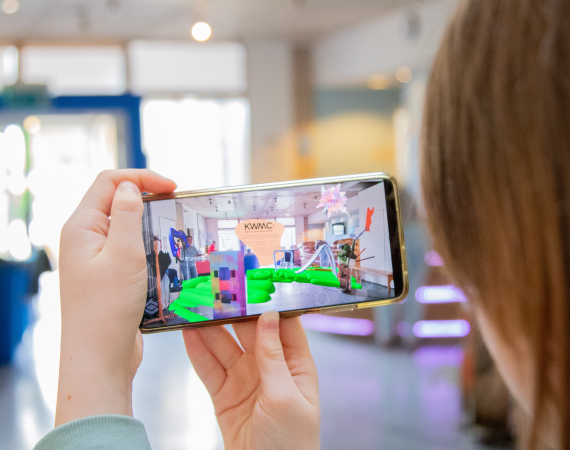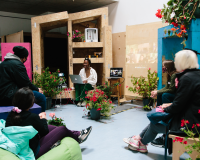Posted on Wed 12 Feb 2025
Knowle West Media Centre Fellowship Summary - Part 1
Reflections on the MyWorld Community Technology Infrastructure Fellowship - KWMC

KWMC community tech
Posted by

David Matunda
Web Developer, Digital Artist, Writer as well as a MyWorld's Fellow in residence at Knowle West Media Centre focusing on community tech and participation.Project

Fellowship in Residence: Community tech infrastructure: creative uses, community access and innovation
A 10 month practical MyWorld Fellowship aimed at exploring, testing and developing creative, accessible ways of utilising the growing KWMC community tech infrastructure.In part 1 of this 3-part series of blog posts, I’ll give a background on community technology as well as Knowle West Media Centre where I was based for the Fellowship. Part 2 of 3 will cover the different community technology infrastructure projects. Part 3 is a summary of my reflections on the Fellowship.
From November 2023 to September 2024 I was selected to take part in a MyWorld Fellowship produced by Watershed. It was based at Knowle West Media Centre (KWMC) in South Bristol. The full title of the residency was ‘Fellowship in Residence: Community tech infrastructure: creative uses, community access and innovation’.
In this summary I’ll reflect on what community tech infrastructure is as I’ve come to understand it as an artist/creative technologist throughout my time on the Fellowship. I’ll be referring to projects and prototypes I made during the residency as well as conversations with different people involved with the KWMC or who work with community tech in general.
Professor Rebecca (Beckie) Coleman is the current researcher in residence at KWMC. I had a conversation with Beckie at the end of the Fellowship where we both reflected on community technology infrastructure, KWMC and my time on the Fellowship in preparation for writing this summary.
I’ll make reference to the conversation with Beckie at the end of the Fellowship but it’s important to know that in the early stages of the Fellowship I met with other KWMC team members regularly to plan and discuss how KWMC can best serve its community through creative uses of technology and community technology.
The Knowle West Neighbourhood and KWMC History
The residency was place-based and KWMC itself has an interesting history in the context of the Knowle West neighborhood in South Bristol.
“KWMC works in an urban context of significant disparities in wealth and opportunities. In the south of prosperous but unequal city of Bristol, Knowle West is a 100-year-old council-built estate and in the top 5% of England’s most deprived areas. It is located just three miles from Bristol city centre but is poorly served by transport and often feels disconnected. It bears the scars of the previous extractive industrial model; until 1990 the largest employer was Imperial Tobacco, with workers’ benefits often partly paid in cigarettes.” - Knowle West Media Centre — Community Tech
The actual media centre building itself stands out in the area as an impressive modern building with equally professional media production equipment and facilities. Carolyn Hassan worked with others to realise what would eventually become the KWMC in 1996. KWMC initially had a focus on photography. KWMC was born out of work with the Knowle West Health Association, the current site of KWMC previously held the Knowle West Health Centre.
Looking back at my time on the Fellowship, it’s clear there is a link between the media centre’s initial purpose as a physical site to foster the creativity already within the community through media and an interest in the importance of the health and social outcomes of residents and the community.
Some of the projects from the Fellowship explore ways to engage the community through new media technologies, resident data and different ways to measure health or gauge community sentiment and tell the story of the neighbourhood.
The Fellowship aimed to explore new ways of continuing the location-specific socially engaged work done by the KWMC under the umbrella term of ‘community tech’. The Fellowship’s particular focus on the technical infrastructures that enable this level of highly involved community engagement doesn’t mean this type of work can only happen within a facility like the KWMC.
I began the Fellowship within a MyWorld cohort of two other fellows placed in different organisations in Bristol and Bath with different Fellowship objectives and audiences. In my first meeting with the other two fellows at the Pervasive Media Studio, it was helpful to hear the analogy that our Fellowship providers are all at different stages of development regarding community tech infrastructure. I found it helpful in gaining a higher level understanding even though my Fellowship at KWMC was the only one explicitly focused on community tech infrastructure.
What is Community Tech?
Promising Trouble was a social enterprise working across Digital Exclusion, Health and Wellbeing; Community Development and Inclusion; Equity, Accountability, and Purpose-driven relationship building models as all these fields relate to technology and social justice. Promising Trouble’s enthusiasm for Community Tech is summarised in a blog post on their website where Community Tech is defined as:
“...Community tech - technology that gives power and generates benefit for communities – a vital part of the modern technology ecosystem. ...Community tech helps unlock the potential of everyone, not just entrepreneurs and academics, and helps strengthen the social fabric in trustworthy, beneficial ways. It can generate and retain economic and social value for communities, provide an alternative to big tech, and increase the resilience and autonomy of community organisations. ...” - The Case for Community Tech
Community tech can be many things, it could be a digital editing suite in a community centre or it could be a device to help residents monitor the cost of energy to help reduce bills.
What is Infrastructure?
But then what is infrastructure? Here is a snippet of the conversation I had with Beckie Coleman discussing infrastructures.
https://on.soundcloud.com/1b8WnVJ8LCxzYsyD8
It might be helpful to think about infrastructure as something you notice when it’s not working. When an infrastructure is operating normally it’s an invisible seemingly automatic mechanism which is crucial to keep a system running as expected or to a particular standard. For example, you notice when public transport is delayed or the internet is down or there’s a power cut.
In the context of the Fellowship, the community tech infrastructure I worked with was all the software and hardware tools as well as location-specific resources available at KWMC. I am an artist working with code and electronics so ironically these infrastructures are what allowed me to exercise my creativity in the Fellowship.
Another important point brought up in my conversation with Beckie is that these infrastructures require maintenance to such a degree that Beckie highlighted how she finds it useful to think about infrastructures as processes of “infrastructuring”. I’ll return to the value of this framing in my closing thoughts.